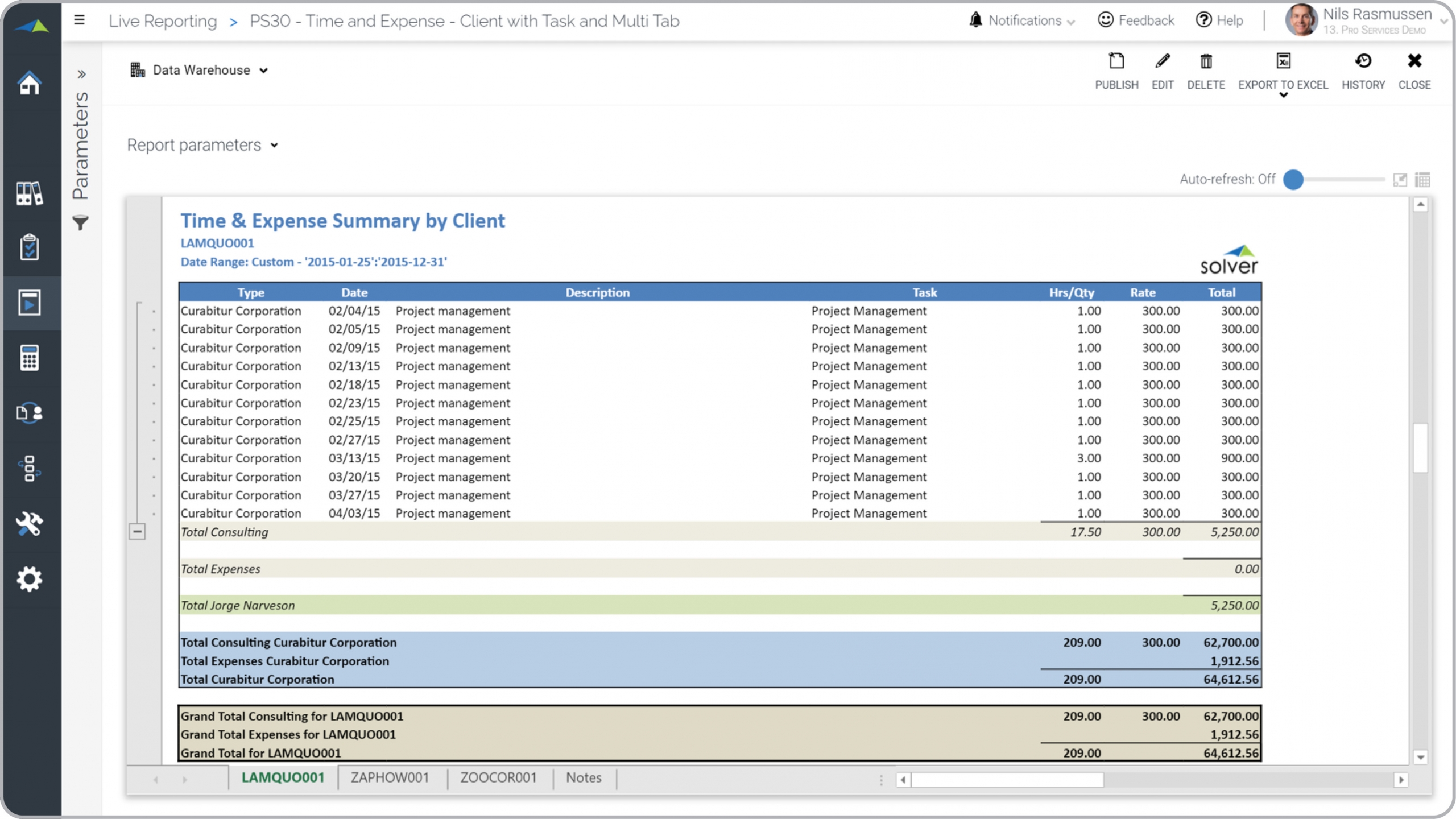Time and Expense Summary Report by Client for Professional Services Companies
What is
a
Time and Expense Summary Report
? Time and Expense Summary Reports are considered operational analysis tools and are used by Project Managers (PMs) and Consulting Managers to get clear insight to both hours and client billing amount details. Some of the main functionality in this type of report is that it can be run for any date range and for one or many clients. In the latter case, each client report is dynamically generated on a separate tab in the report. The rows (not all are visible in the example below) include both out-of-pocket expenses as well as hours and billing amounts, all adding up to a summary at the bottom of the report. Each row section is sub-grouped by consultant working for the client. The columns include: Dates, descriptions, tasks, hours/quantity, rate and amount. You find an example of this type of report below.
Purpose of
Time and Expense Summary by Client Reports Professional Services organizations use Time and Expense Summary by Client Reports to enable clear analysis of hours and expenses associated with each client for the selected date range. When used as part of good business practices in PMO and Consulting departments, a company can improve its client strategies and planning, and it can reduce the chances that poor decisions are made because of lack of good and clear client reports.
Example of a
Time and Expense Summary by Client Report
s Here is an example of a multi-tab Client Time & Expense Report with project expenses, hours and billable amounts. [caption id="" align="alignnone" width="2560"]
 Example of a Time and Expense Summary Report by Client for Professional Services Companies[/caption] You can find hundreds of additional examples
here
Who Uses This Type of
Report
? The typical users of this type of report are: Service Leaders, Project Managers, Consultants.
Other Reports Often Used in Conjunction with
Time and Expense Summary by Client Reports Progressive PMO and Consulting departments sometimes use several different Time and Expense Summary by Client Reports, along with consultant billing reports, client dashboards, detailed project and summary reports, project forecast models, annual budget models and other management and control tools.
Where Does the Data for Analysis Originate From? The Actual (historical transactions) data typically comes from enterprise resource planning (ERP) systems like: Microsoft Dynamics 365 (D365) Finance, Microsoft Dynamics 365 Business Central (D365 BC), Microsoft Dynamics AX, Microsoft Dynamics NAV, Microsoft Dynamics GP, Microsoft Dynamics SL, Sage Intacct, Sage 100, Sage 300, Sage 500, Sage X3, SAP Business One, SAP ByDesign, Acumatica, Netsuite and others. In analyses where budgets or forecasts are used, the planning data most often originates from in-house Excel spreadsheet models or from professional corporate performance management (CPM/EPM) solutions.
What Tools are Typically used for Reporting, Planning and Dashboards? Examples of business software used with the data and ERPs mentioned above are:
Example of a Time and Expense Summary Report by Client for Professional Services Companies[/caption] You can find hundreds of additional examples
here
Who Uses This Type of
Report
? The typical users of this type of report are: Service Leaders, Project Managers, Consultants.
Other Reports Often Used in Conjunction with
Time and Expense Summary by Client Reports Progressive PMO and Consulting departments sometimes use several different Time and Expense Summary by Client Reports, along with consultant billing reports, client dashboards, detailed project and summary reports, project forecast models, annual budget models and other management and control tools.
Where Does the Data for Analysis Originate From? The Actual (historical transactions) data typically comes from enterprise resource planning (ERP) systems like: Microsoft Dynamics 365 (D365) Finance, Microsoft Dynamics 365 Business Central (D365 BC), Microsoft Dynamics AX, Microsoft Dynamics NAV, Microsoft Dynamics GP, Microsoft Dynamics SL, Sage Intacct, Sage 100, Sage 300, Sage 500, Sage X3, SAP Business One, SAP ByDesign, Acumatica, Netsuite and others. In analyses where budgets or forecasts are used, the planning data most often originates from in-house Excel spreadsheet models or from professional corporate performance management (CPM/EPM) solutions.
What Tools are Typically used for Reporting, Planning and Dashboards? Examples of business software used with the data and ERPs mentioned above are:
- Native ERP report writers and query tools
- Spreadsheets (for example Microsoft Excel)
- Corporate Performance Management (CPM) tools (for example Solver)
- Dashboards (for example Microsoft Power BI and Tableau)
Corporate Performance Management (CPM) Cloud Solutions and More Examples
July 16, 2021
TAGS:
Reporting,
Solver,
report writer,
Microsoft,
template,
practice,
Acumatica,
Netsuite,
Finance,
planning,
GP,
Business Central,
excel,
ax,
forecast,
Budget,
billable hours,
Professional Services,
Dynamics 365,
billable expenses,
budgeting,
project report,
Cloud,
Software,
client billing report,
client,
Tableau,
SAP,
example,
best,
Sage,
BC,
D365,
NAV,
Intacct,
services,
project,
PM,
CPM,
report,
SL,
Management,
dynamics,
Power BI

